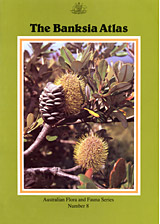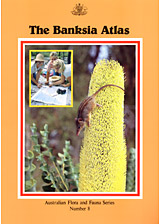
The Banksia Atlas
Encyclopedia


Atlas
An atlas is a collection of maps; it is typically a map of Earth or a region of Earth, but there are atlases of the other planets in the Solar System. Atlases have traditionally been bound into book form, but today many atlases are in multimedia formats...
that documents the range
Range (biology)
In biology, the range or distribution of a species is the geographical area within which that species can be found. Within that range, dispersion is variation in local density.The term is often qualified:...
s, habitat
Habitat (ecology)
A habitat is an ecological or environmental area that is inhabited by a particular species of animal, plant or other type of organism...
s and growth forms of various species
Species
In biology, a species is one of the basic units of biological classification and a taxonomic rank. A species is often defined as a group of organisms capable of interbreeding and producing fertile offspring. While in many cases this definition is adequate, more precise or differing measures are...
and other subgeneric taxa of Banksia
Banksia
Banksia is a genus of around 170 species in the plant family Proteaceae. These Australian wildflowers and popular garden plants are easily recognised by their characteristic flower spikes and fruiting "cones" and heads. When it comes to size, banksias range from prostrate woody shrubs to trees up...
, an iconic Australia
Australia
Australia , officially the Commonwealth of Australia, is a country in the Southern Hemisphere comprising the mainland of the Australian continent, the island of Tasmania, and numerous smaller islands in the Indian and Pacific Oceans. It is the world's sixth-largest country by total area...
n wildflower genus
Genus
In biology, a genus is a low-level taxonomic rank used in the biological classification of living and fossil organisms, which is an example of definition by genus and differentia...
. First published in 1988, it was the result of a three-year nationwide program involving over 400 amateur and professional volunteers.
The Banksia Atlas project was modelled on the Atlas of Australian Birds project, a citizen science
Citizen science
Citizen science is a term used for the systematic collection and analysis of data; development of technology; testing of natural phenomena; and the dissemination of these activities by researchers on a primarily avocational basis...
project that has mobilised over 7,000 volunteers to collect bird sighting data since 1978. While the Atlas project was underway, Dr Stephen Hopper
Stephen Hopper
Stephen Donald Hopper is a Western Australian botanist, specialising in conservation biology and vascular plants. He has written eight books, and has over 200 publications to his name. He was Director of Kings Park in Perth for seven years, and CEO of the Botanic Gardens and Parks Authority for five...
became interested in establishing similar projects for mapping the Australian flora. Between 1979 and 1983, Hopper ran two pilot projects, testing the use of volunteers and computer mapping for the recording of sightings of kangaroo paw
Kangaroo paw
Kangaroo paw is a common name for a number of species, in two genera of the family Haemodoraceae, that are endemic to the south-west of Western Australia. These perennial plants are noted for their unique bird attracting flowers...
and various orchids of Western Australia
Orchids of Western Australia
Among the many wildflowers in Western Australia, there are around 450 species of orchids.-Early identifications:One of the first botanists to study Western Australia was Archibald Menzies, aboard HMS Discovery, who explored King George Sound in 1791...
. In 1983 he was approached by the Australian Biological Resources Study
Australian Biological Resources Study
Australian Biological Resources Study is a project undertaken by Parks Australia Division of Australia's Department of the Environment, Water, Heritage and the Arts ....
(ABRS), who wished to pilot a nationwide distribution study of a significant plant genus. The Banksia genus was chosen as a high-profile, widely distributed genus that was easily identified, but for which distribution and habitat was poorly known. Funded by the ABRS and the Department of Conservation and Land Management, the project started in February 1984 and went public in July. Data was collected for over two years, during which time over 25,000 records of taxa were received from over 400 volunteers.
As a result of The Banksia Atlas project, two new species, B. epica
Banksia epica
Banksia epica is a shrub that grows on the south coast of Western Australia. A spreading bush with wedge-shaped serrated leaves and large creamy-yellow flower spikes, it grows up to 3½ metres high. It is known only from two isolated populations in the remote south east of the state, near the...
and B. oligantha
Banksia oligantha
Banksia oligantha, commonly known as Wagin Banksia, is an endangered species in the plant family Proteaceae endemic to south west Western Australia. It belongs to Banksia subg. Isostylis, a subgenus of three closely related Banksia species with dome-shaped heads as inflorescences, rather than...
(Wagin Banksia), were discovered in Western Australia, new varieties of B. oblongifolia
Banksia oblongifolia
The Fern-leaved Banksia is a species of shrub in the plant genus Banksia. It occurs along the eastern coast of Australia from Wollongong, New South Wales in the south to Rockhampton, Queensland in the north...
(Fern-leaved Banksia), B. occidentalis
Banksia occidentalis
The Red Swamp Banksia or Waterbush is a species of shrub or small tree in the plant genus Banksia. It occurs on the south coast of Western Australia in three disjunct populations: at Augusta, around Albany and in the Esperance area.A 1980 field study at Cheyne beach showed it to be pollinated by...
(Red Swamp Banksia), B. seminuda
Banksia seminuda
Banksia seminuda, commonly known as the River Banksia, is a tree in the plant genus Banksia. It is found in south west Western Australia from Dwellingup to the Broke Inlet east of Denmark . It is often mistaken for and was originally considered a subspecies of the Banksia littoralis...
(River Banksia) and B. spinulosa
Banksia spinulosa
The Hairpin Banksia is a species of woody shrub, of the genus Banksia in the Proteaceae family, native to eastern Australia. Widely distributed, it is found as an understorey plant in open dry forest or heathland from Victoria to northern Queensland, generally on sandstone though sometimes also...
(Hairpin Banksia) were recognised, and a cultivar
Cultivar
A cultivar'Cultivar has two meanings as explained under Formal definition. When used in reference to a taxon, the word does not apply to an individual plant but to all those plants sharing the unique characteristics that define the cultivar. is a plant or group of plants selected for desirable...
of B. serrata
Banksia serrata
Banksia serrata, commonly known as Old Man Banksia, Saw Banksia, Saw-tooth Banksia and Red Honeysuckle, is a species of woody shrub or tree of the genus Banksia in the Proteaceae family. Native the east coast of Australia, it is found from Queensland through to Victoria with outlying populations on...
(Saw Banksia), Banksia 'Superman'
Banksia 'Superman'
Banksia 'Superman, also known by its extended cultivar name Banksia serrata 'Superman, is a registered Banksia cultivar. Its leaves and inflorescences are most the twice the size of typical plants of its parent species, Banksia serrata...
, was registered. A number of hybrids were recorded for the first time, and some rare flower colour variants were noted. Knowledge of distribution was increased for virtually every species, with the range extended to significant new locations for around 40 species. Previously unknown populations were discovered for a number of rare Banksia species, adding to the knowledge of the conservation status of these species. For example B. chamaephyton
Banksia chamaephyton
The Fishbone Banksia is a species of prostrate shrub in the plant genus Banksia. It occurs in sandplain country amongst low heath north of Perth, Western Australia.....
(Fishbone Banksia) was struck off the list of declared rare plants as a result of knowledge gained during The Banksia Atlas project.
Edited by Anne Taylor and Stephen Hopper and published by the Australian Government Publishing Service, The Banksia Atlas was first published in 1988 and reprinted with amendments in 1991. It presents distribution information for 75 species, 1 subspecies and 14 varieties of Banksia. For each taxon
Taxon
|thumb|270px|[[African elephants]] form a widely-accepted taxon, the [[genus]] LoxodontaA taxon is a group of organisms, which a taxonomist adjudges to be a unit. Usually a taxon is given a name and a rank, although neither is a requirement...
the Atlas provides an illustration and brief discussion. A distribution map is provided, along with a breakdown of observation data showing population sizes, growth forms, habitat types, response to fire, flowering times, and observed pollinators.

